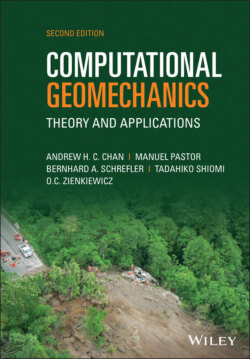Читать книгу Computational Geomechanics - Manuel Pastor - Страница 10
1 Introduction and the Concept of Effective Stress 1.1 Preliminary Remarks
ОглавлениеThe engineer designing such soil structures as embankments, dams, or building foundations should be able to predict the safety of these against collapse or excessive deformation under various loading conditions which are deemed possible. On occasion, he may have to apply his predictive knowledge to events in natural soil or rock outcrops, subject perhaps to new, man‐made conditions. Typical of this is the disastrous collapse of the mountain (Mount Toc) bounding the Vajont reservoir which occurred on 9 October 1963 in Italy (Müller 1965). Figure 1.1 shows both a sketch indicating the extent of the failure and a diagram indicating the cross section of the encountered ground movement.
In the above collapse, the evident cause and the “straw that broke the camel’s back” was the filling and the subsequent drawdown of the reservoir. The phenomenon proceeded essentially in a static (or quasi‐static) manner until the last moment when the moving mass of soil acquired the speed of “an express train” at which point, it tumbled into the reservoir, displacing the water dynamically and causing an unprecedented death toll of some 4000 people from the neighboring town of Longarone.
Such static failures which occur, fortunately at a much smaller scale, in many embankments and cuttings are subjects of typical concern to practicing engineers. However, dynamic effects such as those frequently caused by earthquakes are more spectacular and much more difficult to predict.
We illustrate the dynamic problem by the near‐collapse of the Lower San Fernando dam near Los Angeles during the 1971 earthquake (Figure 1.2) (Seed, 1979; Seed et al. 1975). This failure, fortunately, did not involve any loss of life as the level to which the dam “slumped” still contained the reservoir. Had this been but a few feet lower, the overtopping of the dam would indeed have caused a major catastrophe with the flood hitting a densely populated area of Los Angeles.
It is evident that the two examples quoted so far involved the interaction of pore water pressure and the soil skeleton. Perhaps the particular feature of this interaction, however, escapes immediate attention. This is due to the “weakening” of the soil–fluid composite during the periodic motion such as that which is involved in an earthquake. However, it is this rather than the overall acceleration forces which caused the collapse of the Lower San Fernando dam. What appears to have happened here is that during the motion, the interstitial pore pressure increased, thus reducing the interparticle forces in the solid phase of the soil and its strength.1
Figure 1.1 The Vajont reservoir, failure of Mant Toc in 1963 (9 October): (a) hypothetical slip plane; (b) downhill end of the slide (Müller, 1965). Plate 1 shows a photo of the slides (front page).
This phenomenon is well documented and, in some instances, the strength can drop to near‐zero values with the soil then behaving almost like a fluid. This behavior is known as soil liquefaction and Plate 2 shows a photograph of some buildings in Niigata, Japan taken after the 1964 earthquake. It is clear here that the buildings behaved as if they were floating during the active part of the motion.
Figure 1.2 Failure and reconstruction of original conditions of Lower San Fernando dam after 1971 earthquake, according to Seed (1979): (a) cross section through embankment after the earthquake; (b) reconstructed cross section.
Source: Based on Seed (1979).
In this book, we shall discuss the nature and detailed behavior of the various static, quasi‐static and dynamic phenomena which occur in soils and will indicate how a computer‐based, finite element, analysis can be effective in predicting all these aspects quantitatively.
